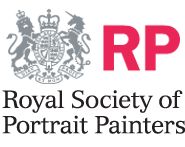Intro to the Series
In ‘What Portrait Painters Need to Know when Working to Commission’ Annabel Elton, Head of Portrait Commissions at the Federation of British Artists gives hints and tips for artists working on Portrait Commissions.
This series of videos, filmed at Heatherley School of Fine Art, focuses on advice for artists preparing for professional practice when working on portrait commissions.
This chapter focuses on Marketing and Promotion.
Other videos in the series include:
- How to Get Yourself Seen: The four curated options
- The Client’s Perspective
- Pricing & Client-Expectations
- Communication: Keeping a Client Happy
This video focuses on social media, artist websites and how both can be used to promote your work as an artist.
Artists and Local Press
Something that has come out of fashion in a way I think because everyone is so quick online, they can neglect the local press.
Portraiture is a bit of a lovely one for this because it’s all about stories. It’s all about people. If you can find a hook and tell your story, an article really does bring you to people’s attention.
I was talking earlier about how people at the exhibition were clicking and taking your information ready for later. And where they go later, is the website.
Artists and Social Media
So when you’re thinking about presenting yourself, the key is the website. Everything else drives to it. But things are changing, Facebook has been used as a platform, but it is waning, it’s Instagram that can grow your target audience.
Instagram can be used for transactions too, as well as to share content. Artists like Emma Hopkins have done very successful work with Instagram with millions of followers and sales.
But generally speaking, it’s more to get people familiar with your work and interested and people will migrate to a website before making contact for a commission.
Pinterest gets a lot of interest. But analysing the people on it for the Royal Society of Portrait Painters, the people we’re attracting are teachers, primarily, it’s very good for interior design. So I can see that we could do better on that front. But right now Pinterest is working more for research than for people wanting to actually commission something.
Artist Websites and Search Engine Optimisation
King here for us and artists is search engine optimisation. If anyone’s Googling your name, it enables them to find you.
It’s a question of having the key phrases written through your website, which can often be:
- Portrait
- Painting
- Painter
- Your name
And anything else special that you want to tell people about what you do. That spreads not only through the text of a website, but on the alt and meta tags, the bits that you put in for people who can’t see the image, as it is another chance to put in your keywords. And it helps with the search engines who will index your website content
Structuring your website to be user-friendly
So how do people look at your website when they want to commission a work of art? It’s very much picture-lead. What they want to see is images of your work. Clients like to see a group of images to get a sense of your body of work, and then to be able to focus on the individual work.
They don’t like lots of fancy stuff before you get there and lots of gateways and moving images and other distracting elements. They want to go straight to examples of your work.
Clients like reassurance and that is what the biography does. In this case, it tells the person looking at a website that you’ve:
- Exhibited your work
- Completed interesting commissions
- Won a prize
When you’re writing your biography, it’s not just all about the way you work or the way you think. You have to subliminally give the messages of reassurance.
Then there is commissions information about how you work so they feel safe that when they contact you, they won’t be left floundering.
A client may want to know:
- How many sittings
- How long the sittings are
- Where the sittings are
Some artists will travel to this sitter and others prefer the safe, consistent conditions of the studio with the good lighting and known quantities.
These are the sort of things to include as website content, so clients know your approach. In terms of managing expectations, how the money works, there’s a question, do you take a deposit?
Artists might want to include when a client becomes committed. If I contact you, will I be committed immediately? Your website content can give your client a sense that they can talk to you softly without becoming committed, that they can explore. And it’s only when they book a sitting that they become committed to this.
A lot of artists will have a work for sale section, where I say be very careful if you’re exhibiting not to double sell it and to take it off your website. It’s quite easy to run into problems if you forget you’ve got work on your website, and then you put it in the gallery
Email Marketing
The other thing is key is contact information. You want people who see your work like it to make contact with you.
As an addition, collect the email addresses because then when you do something interesting or you have a show, you can tell people. We use Campaign Monitor and MailChimp to do that.
You can create a link from their website so people can sign up to your newsletter. Then you’ve collected all the people who have liked your work for when you’ve got something you wish to promote to them.
Annabel Elton is Head of Portrait Commissions at the Federation of British Artists
Other videos in the series include:

